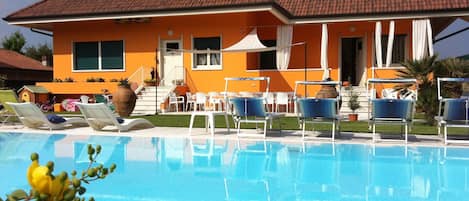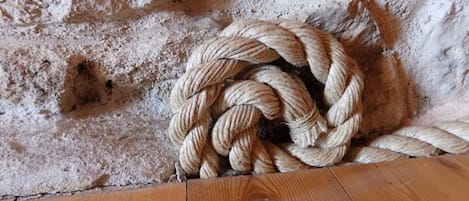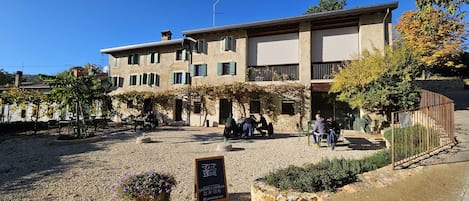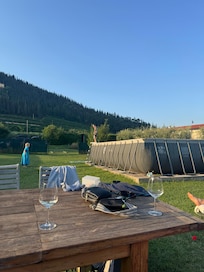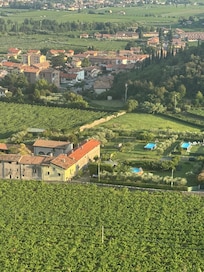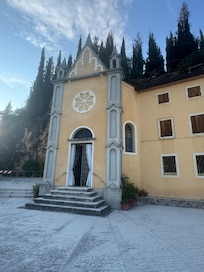Cà Dei Merli is an ancient dryer for the Amarone della Vapolicella grapes finely renovated in 2014, immersed in the tranquility of the valley, the junction point between the city of Verona, Lake Garda and Lessinia.
Located behind Fumane at the foot of Monte Rivoli under the spectacular and suggestive Sanctuary of the Madonna de la Salette which is a fantastic panoramic balcony over the vineyards of Valpolicella, it is the ideal place to recover energy.
Its particular position makes it suitable for both relaxing holidays and cultural tourism, thanks to the convenience with which you can reach the main tourist destinations in the Veneto region, such as Verona, Lake Garda, Venice, Treviso and Trentino.
For lovers of walking and cycling there are paths surrounded by greenery.
For lovers of good food and good wine there are numerous food and wine tours with wine tastings; the owners in love with their territory offer themselves to suggest tasting itineraries.
The house consists of a main area where the owners reside and an independent area reserved for guests.
The old drying room has two rooms with four places each, one with a double bed and a bunk bed; the other instead with two double beds.
There is also a kitchen equipped with oven, fridge, dishwasher and a wood stove to cook in the typical way of this area.
The rooms have air conditioning, TV, are equipped with independent heating and free internet.
The apartment has a laundry room with washing machine and a 400l DHW storage tank to guarantee a constant flow of hot water.
At the entrance there is a comfortable and graceful sitting area for reading, working or writing.
It is possible to have numerous outdoor parking spaces available, inside the property, which can be accessed through a motorized gate.
The property also has an outdoor park with a 7.5X3.5 above-ground swimming pool and is equipped with a sun lounger and barbecue, umbrella, table and chairs for dining.
The town of Fumane is located a few kilometers from one of the best hospitals in the province of Verona, the Negrar hospital, reachable in 20 minutes.
Leisure activities: in the area there are two riding stables, different paths and paths for mountain biking or for lovers of walking.
In the village there are several restaurants and agritourisms.
For those who love good wine since we are in the center of historic Valpolicella there are a hundred wineries that offer tastings and guided tours.
Places to visit: Verona can be reached in 25 minutes as well as Lake Garda and its theme parks such as Gardaland and Caneva World, in 20 minutes you can also reach the Pastrengo zoo safari and in 10 minutes by road you can spend an afternoon to relax at Terme Aquardens, which are the largest in Europe.
In about twenty minutes you can reach the Verona airport.
For mountain lovers in an hour and a half you can be in the Dolomites.
10 minutes from the property, there are also the famous Molina Waterfalls which attract more than 80,000 tourists every year. The peculiarity of this area is the abundance of water, thanks to the existence of perennial springs located north of the town of Molina. In addition to the sparkling waterfalls, the park also offers visitors a landscape marked by woods and meadows, frequently interrupted by streams and rivers that combine the sweetness of the greenery, in the infinite variety of vegetation, with the gray of the rocky spurs.
A synthesis of the low mountain landscape can be found in the Park, where paths and itineraries offer the visitor now the serene solemnity of a cascade of sparkling water, now the expanse of multicolored flowers between a forest and a cliff, now the ravine inhabited by a swirling stream.
In addition, the Tibetan Bridge, a classic engineering work suspended with ropes between opposite sides, is also beautiful to see. It is the first construction of its kind in Veneto and also among the rarities in our country, and connects the trail system of Marano di Valpolicella with that of Sant'Anna d'Alfaedo.
Then we also find the Fumane Caves nearby, which testify to the uninterrupted presence of the Neandertal Man and then of the Homo sapiens sapiens from about 80 thousand to 25 thousand years ago. Finally, but no less interesting, the Veja Bridge, probably frequented since well before the last ice age by a colony of skilled workers of flint artifacts, arrows, tips, needles, leaves us amazed that those prehistoric men (perhaps Neanderthal) traded their precious material for half of Europe, up to the Baltic Sea in present-day Poland, via the Amber route, or to the French end.
Amarone della Valpolicella is a dry DOCG red passito wine produced exclusively in Valpolicella in the province of Verona.
Organoleptic characteristics:
color: deep red possibly tending to garnet with aging;
smell: characteristic, accentuated;
flavor: full, velvety, warm;
maximum residual sugar 12 g / l if the actual alcoholic strength is 14%.
Olfactory hints: ripe fruit, black cherry and raspberry jam.
In the older ones you can also perceive hints of musk and tar, the latter in technical jargon called goudron.
Alcoholic strength: the minimum expected alcoholic strength is 14º, for the full-bodied it can even reach 17º.
The name of this structured Veronese red, Amarone, derives from the word "amaro", adopted to distinguish it from the sweet of Recioto della Valpolicella from which it originated, albeit involuntarily.
The new epithet Amarone to indicate the Recioto Amaro or Recioto Secco was born in the spring of 1936 in the Cantina Sociale Valpolicella, at the time based in Villa Mosconi in Arbizzano di Valpolicella, by the capocantina Adelino Lucchese, exceptional palate and nose that, thanks to the lucky finding a cask of recioto forgotten in the cellar and tapping the Recioto Amaro from the fermentation barrel, he came out in an enthusiastic exclamation: "This is not a Amaro, it is an Amarone".
The foreman had given Valpolicella the magic word.
Amarone has been spoken of since Catullo's time in Carme n. 27 (about 49 BC) claims "calices amariores" (more bitter glasses).
But many other documents bear witness to this.
Traces of the predilection for this wine and for the grapes that produce it is also found in the Edict of Rotari which established very severe penalties for those who caused damage to the vines and high fines for those who stole the bunches.
For the years following 1000 d. C. there is evidence of some deeds of purchase and sale of vineyards in the production area of Amarone della Valpolicella, indeed wine is considered equal to money to pay feudal rights.
In the following centuries the presence of Amarone della Valpolicella continues in the official documents and writings of the humanists.
An estimate of 1503 attests that the production area of Amarone della Valpolicella; it was a rich and famous valley thanks to its wines. Fame that continued until the Enlightenment era when Scipione Maffei in an important text proposed the bitter diction, to indicate the wine "a particular grace produced in Valpolicella".
The experience needed to bring the grapes destined for this precious wine to the right drying is very high.
Withering is essential, so much so that someone called this phase a second harvest.
The grapes, healthy and perfectly ripe not only on the skin but also internally, are selected already at the time of harvest, in the first two weeks of October, choosing the loose bunches, with the berries not too close together, so that they let the circular 'air.
These small dark "nuggets" are distributed in a single layer on the plateaux, large wooden boxes, increasingly replaced by perforated plastic, for ventilation and to ensure faster washability after use.
The plateaux are stacked in the dryers, generally ventilated rooms above the houses and cellars. Useful position for those who have to turn and periodically check the grapes and then work them quickly, at the right time.
The dryers must be in positions where constant ventilation is allowed, controlled by suitably prepared windows, where the temperature can change gradually and where there is no stagnation of humidity. For this reason, some historic cellars are built on bumps and sides of hills in sometimes unlikely positions, outside the rules of small practicality.
Sometimes it was the location of the dryer that decided the location of the entire building.
Withering lasts about 120 days; the most evident visible consequence of this phase, in addition to the wilting of the berries, is the weight loss of the bunches which varies according to the type of grape.
In late January, early February, the grapes are pressed and the maceration on the skins is long.
The fermentation at low temperature is also very slow, even for 30/50 days. This serves to ensure that sugars, due to the effect of yeasts, are transformed into alcohol.
If the final wine maintains a low presence of sugars, it can be defined as Amarone. If the quantity is higher, Recioto is obtained instead.
The grapes left to dry cannot be vinified before December 1st.
A minimum aging of two years is required with effect from 1 January following the harvest.
All grape drying, vinification, seasoning and bottling operations must be carried out in the DOCG area.






